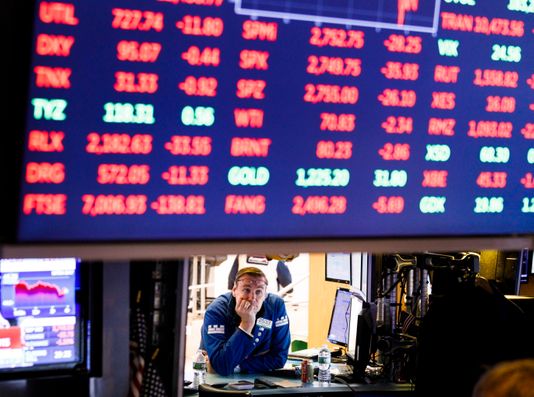
Like flipping a light switch, the tone of the stock market Tuesday went from “get me out” to “get back in.”
A battered market that looked prone to more selling by nervous investors just a day earlier rebounded sharply and flashed signs of stability Tuesday. What stabilized it? A batch of strong earnings reports and fresh signs the economy is still strong.
The Dow Jones industrial average rebounded nearly 548 points on Tuesday, or 2.2 percent, to 25,798, recouping a chunk of its nearly 1,600-point drop in the previous eight trading sessions.
Helping turn the tide was a continuation of the strong start to the quarterly profit-reporting season. Better-than-expected earnings from key Dow components – drugmaker Johnson & Johnson, health insurer UnitedHealth Group and Wall Street powerhouse Goldman Sachs – helped relieve some of the worries that business conditions were weakening and that results would come in worse than feared. Also lifting the mood of investors was a report that showed a record number of job openings in the U.S.

The good economic news “hit the right chord with investors,” says Jack Ablin, founding partner and chief investment officer at Cresset Wealth Advisors. “Near term, it’s all about the business fundamentals.”
In the prior two weeks, investors had been selling stocks amid fears that rising interest rates and the fallout from trade tensions with China would derail the good things happening in the U.S. economy.
Investors’ willingness to take on risk and buy stocks again was in sharp contrast to their defensive stance in the prior five trading days, when finding winners was tough. During that time, only two dozen, or less than 5 percent, of the 500 companies in the Standard & Poor’s 500 stock index had gone up, according to Bloomberg data. During this downbeat stretch, the broad market gauge tumbled 4.6 percent, its biggest sell-off in seven months.
The large-company index, however, rebounded 2.2 percent Tuesday, trimming its decline from its September record high to 4.1 percent. And in another sign of investor optimism, the technology-stock packed Nasdaq composite, which had been hard hit, jumped nearly 3 percent Tuesday. All 30 Dow stocks finished higher.
Prior to Tuesday’s rebound, just a few bright spots had emerged in an otherwise battered market.
Not surprisingly, the best places to shield cash from the storm had been the “defensive” sectors of the market. The stocks that had held up best were companies that sell everyday consumer products or provide services that stay in demand whether the economy is booming or contracting. Shares of companies such as Dollar General, which sells a long list of products such as toothpaste and toilet paper that sell for about a buck, and drugstore retailer Walgreens Boots Alliance and electric and gas utilities such as PSE&G were among those that shielded investors from losses. Gold, a metal that has historically been viewed as a haven when markets turn rocky, also had held up well.
These types of investments could continue to fare well if the stock pullback continues and the incoming data begins to weaken, analysts say.
But Tuesday’s rebound shows that if the market regains its footing quickly, there’s a good chance that many of the former market leaders that got hit the worst in the sell-off could rebound. That’s because investors could return to companies whose business outlooks haven’t necessarily changed, Stovall adds.
Twitter, a social media company, for example, rallied 4.4 percent, extending its gain in the past six sessions to roughly 5 percent – despite an 8.5 percent slide last Wednesday.
Similarly, high-fliers such as chipmaker Nvidia, which had come under intense selling pressure recently, also found buyers Tuesday, gaining more than 4 percent.
“Stocks that get beaten up the most are often the ones investors jump right back into,” Stovall says.
Tuesday’s rally, however, doesn’t mean the market no longer faces risks, says Bruce Bittles, chief investment strategist at investment firm Baird. He says Tuesday’s rally was a snap-back rally after stocks fell too far, too fast. One potential obstacle for stocks is a squeeze of profit margins, he says.
“Profit margins for U.S. companies could get squeezed due to rising tariffs, rising interest rates, rising wages and rising energy costs,” he says.





























